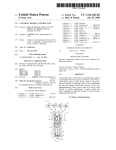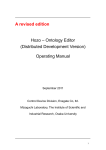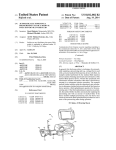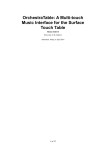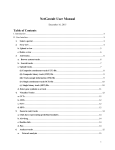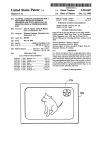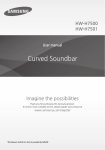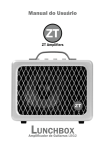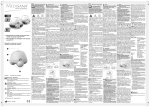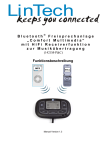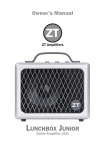Download l|||l||||||||IlllllllllllllllllllllllllllllllllIIIIIlllllllllllllllllllllll
Transcript
l|||l||||||||IlllllllllllllllllllllllllllllllllIIIIIlllllllllllllllllllllll US005440351A United States Patent [191 [11] Patent Number: Ichino [45] [54] [76] Date of Patent: TELEVISION WITH USER-SELECTABLE 4,272,788 RADIO SOUND 4,527,204 7/1985 Kozaki et a1. 4,627,101 2/1985 ’ Inventor: _ 5,440,351 Aug. 8, 1995 6/1981 Ogita ..................................... .. 381/3 . 358/194.1 Anderson et al. 455/ 179.1 Ted Icluno, 7351 Artesla Blvd. #6, 4,688,252 8/1987 Kufta et a1. ............... .. 381/4 Buena Park, Calif. 90621 4,779,129 10/1988 Usee et a1. 5,046,107 9/1991 Iwamatsu 358/189 381/107 [211 APP1-N°-= 63,620 5,097,249 [22] Filed: 5,142,370 8/1992 Wignot et a1. .................... .. 358/189 May 25’ 1993 R l ted U S A r ti ea [63] . . pp lea D ta on 3/1992 Yamamoto ..... .. FOREIGN PATENT DOCUMENTS a 2831014 4/1980 Continuation-impart of Ser. No. 817,137, Jan. 6, 1992, 0017017 2/1978 abandoned. 0045712 31/1982 [51] [52] Int. 01.6 US. Cl. .................................. ............................................. .. 348/729; .. H04N 348/738; 5/60 [58] 455/ 179.1 Fleld of Search ................... .. 358/198, 184, 194.1, 358/165; 455/151.1, 174.1, 178.1, 179.1, 185.1, OTHER PUBLICATIONS Middleton’ Robert G‘, “Television Service Manual,” 5th Edition T Audel Indiana Olis SC 180.2, 187.1, 79; H04N 5/46, 5/60; 381/3, 4, 107, 102, 104, 101; 312/7.2; 348/729, 738, 706 References Cited [56] . 358/194.1 U.S. PATENT DOCUMENTS ’ ‘ ’ P ’ 1984 P‘ 49 ' Primary Examiner-James J. Groody Asszstant Examzner-Jeffrey S. Murrell [57] ABSTRACT 266,502 10/1982 Heijnen ............................ .. 1314/131 279,095 6/1985 Kato et aL ‘‘‘‘ __ D14/131 A televisim‘ S?‘ with an integrated radi" tuner’ such that simulcast radio broadcasts may be played through the 290,007 telev1s1on sound system at the viewer’s discretion. A 5/1987 Mano er a1. , _ _ _ _ , _ , , , ,_ D14/131 292,097 9/1987 Akita et a1. gfalgoto -, 1n 298,534 11/1988 0 .. ... .... .. D14/ 131 user-programmable memory provides the viewer with ---- - the ability to store multiple television channel/radio . . . . .. Turner . . . . . . . . . - . . . . .. 1314/131 - . - fr.eq“en°y ‘ilsswatlfms' A ‘6.111016. control def'we .Pro 300,633 4/1989 .Makino et a1. ........... .. 1314/131 “des the my“ “91.96 “P291119 °f Selectmg 61th“ 305,024 12/1989 Nishiyori et 3L normal television audio or radio s1mulcast sound. 2,617,878 11/1952 2,626,315 “ D14/131 Goldfus .......... .. 358/189 1/1953 Farr ........ .. 358/189 4 Claims, 7 Drawing Sheets 5 UHF / ANTENNA l0 ,-/2 F20 UHF SIGNALS UHF MIXER/ VIDEO (ALL UHF CHANNELS) OSCILLATOR PROCESSING 2*’ SINGLE UHF “1421M CHANNEL l4 VHF SIGNALS (ALL VHF CHANNELS) VHF RF AMPUFIER SINGLE TV CHANNEL TV VIDEO VHF MIXER/ OSCILLATOR TV AUDIO 25 r ---------------------------------------------- — - C- - — -: | 23 I RADIO ‘ TV AUDIO IANTENNA PROCESSING / 1 Z5 : I I 28 .32“ I I ' | L. 4 P‘ f3, RADIO SIGNALS Ag)? TUNER 1 24 $111015 RADIO STATION IIMPK I I - __________________________ _I"_/R_A2'2 MP1? IE°EEEEILL ' 1 1 US. Patent Aug. 8, 1995 Sheet 7 0f 7 5,440,351 FIG. 7 X FREQ. 38 FIGS 1047 2058 3069 FREQ. ENTER TV/RADIO m9@w @Wv aha p @M 46' 1 5,440,351 TELEVISION WITH USER-SELECI‘ABLE RADIO SOUND This is a Continuation-In-Part of Ser. No. 07/817,137, ?led Jan. 6, 1992, now abandoned. BACKGROUND-DESCRIPTION OF PRIOR ART Heretofore, only FM radio simulcasts could be substi 2 synergy between a video cassette recorder and a televi sion set. Kozokai’s remote control device cannot be compared with the remote control device of this inven tion. Kozokai’s remote control device merely simpli?es the interactions of two already interdependent video media, rather than establishing new interactions be tween two dissimilar and non-interdependent media. Kozokai’s remote control device automates the steps necessary to display a VCR signal through a television set; it performs only mandatory actions. In contrast, a tuted for a normal television audio program; a viewer switch on a remote control device which causes radio has not previously had the option of substituting an AM sound to be substituted for television audio creates an interaction between two different media; a new rela radio simulcast for a television audio program. Televi sion audio engineers have traditionally seen radio simul casts as merely stereo versions of the original television audio broadcast, and have either provided no simulcast capability or the ability to substitute FM radio simul casts for the television audio program. The similarities between FM radio circuitry and television audio cir cuitry, which permit FM radio signals to be ampli?ed through pre-existing television audio circuits, have rein tionship between the two media. This switch is not essential to the operation of a normal television. It is only useful when a receiver capable of decoding AM radio transmissions is incorporated into a television set, at which time it provides the new and unexpected result of allowing the viewer to choose between the normal 20 television audio program and _a radio simulcast at the touch of a button. This switch is neither obvious nor forced this mindset. A number of inventions which cost-effective if only FM radio simulcasts are consid ered. Because FM simulcasts differ from the original normal television audio program exist in the prior art; television audio program by being in stereo, and most however, none of these designs will accommodate AM 25 television sets provide marginal stereo separation, there allow an FM radio simulcast to be substituted for a radio simulcasts. By ignoring AM radio, these teachings is no reason to provide such a switch for a television exclude nearly all radio simulcasts, since the vast major with FM-only simulcast capability. Even if the average television set had widely-separated speakers and excel lent stereo separation, the scarcity of FM radio simul ity of all radio simulcasts are found on AM radio. Portable units with both televisions and AM/FM radios have been produced, but the radio of these com casts would prevent such a switch from being cost-ef bination units has always been separate from the televi fective. The prior art recognizes this and provides cir sion of the unit; no provision to substitute radio sound cuits which automatically compare the strength of the for television audio has been provided. The radio and FM simulcast signal against the strength of the televi television of these combination units have been per sion audio signal, automatically selecting the stronger of ceived as separate entities which happen to share a 35 the two signals. The viewer is not burdened with a common housing. choice between television audio and FM simulcast It is well known in the prior art that television audio sound, since the two are essentially identical. circuits can be used to amplify FM radio signals; indeed, Iwamatsu, US. Pat. No. 5,046,107 (1991) discloses a Middleton teaches that television audio circuitry is device which adjusts volume such that when the user quite similar to the circuitry of an FM radio. The prior 40 switches among various audio sources, the volume re art has made heavy use of this similarity. Wignot et al., mains constant. He describes a memory which stores US. Pat. No. 5,142,370 (1992); Uee et al., US. Pat. No. preset volume levels and associates each preset volume 4,779,129 (1988); Ogita, US. Pat. No. 4,272,788 (1981); level with a particular device. Like Kozokai, this device and foreign patents Gorenje, DT 2831-014 (1980); Hita chi, 53-17017 (1978); Suzuki, 57-45712(A) (1982); and Saitou, 57-155885(A) (1982) all use television audio re?nes pre-existing relationships, rather than creating 45 new attributes. In contrast, a memory which can associ ate a radio frequency with a given television channel circuitry to amplify the radio signal. Wignot carries this and make this radio frequency available whenever the circuit-sharing to its logical extreme, disclosing a way television is tuned to the channel creates a new attribute for the television channel. It creates a new relationship to make a television audio circuit function ef?ciently as an FM radio receiver. 50 between the television channel and the radio frequency, Every instance of applicable prior art known to the applicant has either ignored the potential synergy be with the new and unexpected result that the viewer has a choice between the standard television audio program tween radio sirnulcasts and television sets, or else lim~ and one or more radio simulcasts which describe the ited itself solely to FM radio simulcasts by routing the same event, but which differ in content among them radio signal through television circuitry to be ampli?ed. selves and the original television audio broadcast. The need of the non-English-speaking person to Television audio circuits cannot be shared with an AM radio; the intermediate frequencies of the two signals are too dissimilar. Besides excluding AM radio simul casts, the prior art has the additional disadvantage of watch a television picture while listening to a simulcast in his or her native tongue has not heretofore been fully addressed. Second-language simulcasts are to be found depending on a particular television broadcast format. 60 on AM, not on FM radio. Television broadcasters have It is unlikely that Saitou’s device will work in conjunc tion with an HDTV television set: Saitou, along with the entire body of applicable prior art, relies on a fortu attempted to accommodate non-English-speaking per sons by offering a Secondary Audio Program (SAP), but not all languages are covered; nor is SAP offered itous similarity between television audio circuitry and for every program; nor is SAP available on every FM radio that has little chance of surviving the transi 65 broadcast channel. Radio simulcasts in a number of tion from analog to digital television. languages exist today; the prior art has ignored them by Kozokai et al., US. Pat. No. 4,527,204 (1985) dis designing televisions which are either con?ned to re closes a remote control device which facilitates the ceiving FM radio broadcasts or which cannot receive 3 5,440,351 4 radio broadcasts at all. The present invention allows Another object and advantage is to provide a sports AM foreign-language simulcasts to be easily accessed, fan with a convenient way of watching a sports event on television while listening to a radio simulcast of the without impairing the viewer’s ability to receive a tele vision SAP audio broadcast. Many sports fans would prefer to watch sports on television while listening to the play-by-play commen tary from their local radio announcer, but desire the option to hear the normal television audio program same event. Another object and advantage is to provide a method of quickly and easily switching back and forth between the television audio program and the radio simulcast. Another object and advantage is to provide this abil when statistics are displayed or during interviews or ity to switch between the television audio program and replays. Again, these sports simulcasts are found on the 10 the radio simulcast using a remote control device. AM radio band, not on FM radio. The present invention Readers will ?nd further objects and advantages of gives these sports fans the “best of both worlds”—they the invention from a consideration of the ensuing de can listen to the radio announcer for the play-by-plays; switch to the television announcer for the replays, sta scription and the accompanying drawings. BRIEF DESCRIPTION OF DRAWINGS The invention will best be understood when the ensu ing description is taken in conjunction with the accom tistics, and interviews; and switch back to the radio announcer when play resumes. The need of a viewer of alternate television formats, such as HDTV and cable, to access AM simulcasts has panying drawings in which: not heretofore been addressed. By keeping the interde FIG. 1 is a block diagram of a television (TV) set pendency between the host television and the AM radio 20 showing the basic concepts o_f_converting signals for to a minimum, the present invention will work with a audio/video processing as shown in prior art. wide variety of television sets. All that is required is a FIG. 2 is a block diagram of a TV set in conjunction television which eventually separates the Audio signal from the Video signal and sends this Audio signal to the speaker system to be reproduced. with a radio tuner as shown in prior art. FIGS. 3, 5 and 7 are block diagrams of a TV appara 25 tus in conjunction with a radio tuner in accordance with the present invention. OBJECTS AND ADVANTAGES Accordingly, one object and advantage of the inven tion is to provide the television viewer with a choice between listening to the regular television audio pro gram and a radio simulcast. The viewer would be free to associate any television channel with any AM radio FIGS. 4, 6 and 8 are block diagrams of a TV appara tus in conjunction with both a radio tuner and a pro grammable memory in the preferred embodiment of the present invention. FIG. 7 is a front view of a TV screen with a special inset window which displays the radio frequency set station, but would presumably select an appropriate ting as it is entered by the user. The dotted rectangles radio station which is broadcasting an alternate audio are intended to show the location of the displayed digits program for the television program being watched. 35 of the radio frequency setting, and will not appear on Another object and advantage is to provide the tele the actual display. vision viewer with a choice between listening to a FIG. 8 is a front view of a TV remote control device shortwave, CB, FM, AM, or another type of radio simulcast instead of listening to the normal television in accordance with the present invention. The block diagrams have been drawn to illustrate the invention with maximum clarity, rather than to produce the most efficient device. For instance, in practice the audio program. This invention has the potential to sub stitute virtually any kind of radio broadcast for a televi sion audio program; it is not limited to AM simulcasts. The discussion below focusses on providing AM radio television audio signal would probably not be separated from the video signal at the stage shown in the dia grams. Rather, it would most likely be allowed to go capability solely because this is where the vast majority of simulcasts are currently to be found. Another object and advantage is to provide the viewer with a convenient means of storing frequently used radio frequencies, and to provide a means of asso 45 through several stages of ampli?cation along with the video signal and would be separated at a much later stage than shown in the block diagrams, saving the cost of a couple of audio ampli?ers. As another example, the ciating each of these frequencies with a television chan means of switching between the normal television audio nel. This would give the user the ability to designate 50 program and a radio simulcast is depicted as a button on which radio station, if any, is an appropriate alternative a remote control device. In practice, this button could audio source for a given television channel and to en be a rocker switch, a slide switch, a toggle switch, a sure that only this radio station would be available for the television channel. pushbutton with a different shape, or any type of switch capable of selecting a single audio source from two or Another object and advantage is to provide the 55 more audio sources. There could even be two different viewer with a choice between listening to a radio simul cast and the audio program of an HDTV broadcast. Another object and advantage is to provide the buttons or switches which accomplish this selection: one which selects the normal television audio program when actuated, and one which selects the radio simul viewer with a choice between listening to a radio simul cast when actuated. cast and the audio program of a cable television broad 60 DETAILED DESCRIPTION OF THE cast. Another object and advantage is to provide the above features in a fashion which requires a minimum of skill and training to use. DRAWINGS Referring to FIG. 1, a television set/apparatus 5 is broken into blocks to show the basic concepts of receiv An additional object and advantage is to provide a 65 ing incoming television signals and the video/audio non-English-speaking person with a convenient way of processing entailed in converting these signals to a dis listening to a radio simulcast in his native language playable form. The system includes UHF antenna 10 while viewing the associated television picture. which receives incoming UHF signals and sends these 5 5,440,351 6 signals to a UHF mixer/oscillator 12. Mixer/oscillator 12 contains a mixer to select a single television channel a given AM radio frequency with a given television channel, has been added to television set 5. As the from the multitude of signals received, and radio fre quency tuning circuits (not shown) to convert the chosen channel into an intermediate frequency. The resultant signal can be processed by the VHF circuitry, memory 34 contains an associated simulcast radio fre viewer changes channels, memory 34 is checked, and if quency corresponding to the current television channel, this simulcast radio program is automatically made available to the viewer (i.e., AM radio tuner 30 is auto matically tuned to this associated radio frequency). If an and thus is sent to the VHF RF ampli?er 16. Altemately, the VHF antenna 14 receives incoming VHF signals and sends these signals to to the VHF RF associated simulcast frequency does exist for the televi sion channel, it is briefly displayed in inset window 38 ampli?er 16, which selects the desired frequency and rejects all others. In the VHF mixer/oscillator 18 this ampli?ed signal is converted to an intermediate fre quency. If the signal is a UHF IF from mixer/oscillator 12, the input UHF IF is ampli?ed twice: once by the VHF RF ampli?er 16, and again by the VHF mixer/os on television screen 36. Whether or not an associated simulcast frequency is available, memory 34 can be programmed by selecting an AM radio frequency, at which time this AM radio frequency and the currently 15 tuned television channel are stored as an association into cillator 18. memory 34. Video processing 20 mainly ampli?es and synchro Memory 34 can also optionally keep track of which nizes the vertical and horizontal signals, and outputs of the two audio sources was last active on a given them to the TV picture tube. Since this video process channel, and reactivate the same source when returning ing is well known to the art, the system has been simpli 20 to the channel (e.g., if the view/gr is watching Channel ?ed and depicted as a block. 14 while listening to a simulcast, and decides to change As shown in FIG. 2, a radio antenna 28, an FM radio tuner 29, and a two-way switch 32 are added to televi stations during a commercial break, when he/she re turns to Channel 14 the simulcast, rather than the nor sion set 5. The FM radio tuner 29 selects the desired mal television audio, will be heard). simulcast radio signal from the plurality of radio signals 25 received by the radio antenna 28 and reconstructs the FIGS. 5 and 6 are modi?cations of the embodiments of FIGS. 3 and 4 respectively wherein different radio original audio signal. Since this process of selecting and demodulating a radio signal is well known to prior art, tuners are utilized. FIG. 7 shows sample television screen 36 with inset window 38 which appears when the viewer attempts to it has been simpli?ed and depicted as a block. It is also well known that FM radio signals can be ampli?ed set AM radio tuner 30 of either FIG. 3 or FIG. 4 to a using television audio circuitry; thus the signal is sent to Television Audio Processing for ampli?cation. Switch 32 determines whether the television audio signal or the desired frequency. Inset window 38 can also appear when the television is tuned to channel for which an associated simulcast frequency exists. In the interests of economy and ease of operation, the display has been FM radio signal is ampli?ed, picking the stronger of the two signals. The ampli?ed signal is then sent to Televi 35 kept simple. sion Sound System 26, to be heard by the viewer. For FIG. 8 shows remote control device 40, which can be clarity, and to contrast the prior art with the present used to program AM radio tuner 30 of FIG. 3, or AM invention, the audio processing has been segregated into radio tuner 30 and programmable memory 34 of FIG. 4. a single block, TV/Radio audio processing 25. To program AM radio tuner 30, the viewer ?rst presses As shown in FIG. 3, radio antenna 28, AM radio 40 Freq button 42 on remote control 40. Radio program tuner 30, and two-way switch 32 are added to television set 5. AM radio tuner 30 selects the desired simulcast ming inset window 38 now appears on television screen 36, and the numeric keypad of remote control 40 now radio signal from the plurality of radio signals received by radio antenna 28, and reconstructs the original audio serves to program AM radio tuner 30 rather than to select a television channel. As the viewer punches in signal. Since this process of selecting and demodulating 45 each digit of a radio frequency, the number is echoed to a radio signal is well known to prior art, it has been radio programming inset window 38. When the fre simpli?ed and depicted as a block. This simulcast radio quency is satisfactory, the viewer presses Enter button signal is sent to AM radio signal ampli?er 24 and then to 46. In the device of FIG. 3, AM radio tuner 30 is now Television Sound System 26 through switch 32. The set to the selected frequency, the simulcast radio pro television audio signal is independently ampli?ed 50 through Television Audio Processing 23 and sent to Television Sound System 26 through switch 32. For clarity, these two processes have been segregated into a single block, TV/Radio Audio Processing 25. Switch gram is played through Television Sound System 26, the numeric keypad of remote control 40 is restored to its normal function of selecting television channels, and the television picture is restored to normal. In the de vice of FIG. 4, the same thing happens, with the addi 32 ensures that only one of the two audio sources is 55 tional effect of forming a correlation between the cur active at any given time, and allows the viewer to change back and forth between the television audio program and the radio simulcast. Switch 32 can be actuated either manually or by actuating a switch on a remote control device. No changes need be made to 60 rently tuned television channel and the selected simul cast frequency, and entering this television channel/ra dio frequency association into programmable memory When Enter 46 button is pressed in the device of FIG. 4, memory 34 is checked to see if the television channel the set is currently tuned to already exists in memory 34. If so, the existing entry has its radio fre quency ?eld overwritten with the newly-entered radio work with any television set which separates the televi~ 65 frequency. If no entry for the current television channel sion audio signal from the television video signal. is found, a new entry is created, consisting of the cur FIG. 4 is the preferred embodiment of the present rent television channel and the newly-entered radio Television Audio Processing 23; it can be completely normal and indistinguishable from the circuitry of a standard television set. This independence from Televi sion Audio Processing allows the present invention to invention. Programmable memory 34, which correlates frequency. 5,440,351 7 8 optionally keep track of which audio source was last vision picture; window 38 displaying the selected radio active on this channel. Programmable memory 34 has the capability to store a single television channel AM frequency is eliminated. At the same time, the numeric radio frequency association or a number of such associa keypad of remote control 40 is restored to normal oper ation; that is, pressing a button or buttons of the numeric 5 tions. When the television is ?rst turned on, the viewer keypad will now serve to select a television channel will always receive the normal television audio pro rather than to program a radio frequency. gram, regardless of the contents of programmable mem TV/Radio button 44 on remote control 40 toggles ory 34. If the viewer attempts to switch to an AM radio back and forth between the radio simulcast and the simulcast using TV/Radio button 44, memory 34 is Pressing Enter button 46 also restores a normal tele normal television audio program. As mentioned previ~ ously, this does not have to be a button; it can be any one of a variety of switch types. searched to see if a radio frequency has been associated with the channel that television 5 is tuned to. If this television channel cannot be found in memory 34, no action is taken. If the channel is found in memory 34, LIST OF REFERENCE NUMERALS the associated AM radio frequency is brie?y displayed 5. Television (TV) Set/Apparatus 10. Ultra-High Frequency (UHF) Antenna 15 in inset window 38, AM radio tuner 30 is set to the‘ associated radio frequency, and this AM radio simulcast 12. UHF Mixer/UHF Oscillator is reproduced through Television Sound System 26. 14. Very High Frequency (VHF) Antenna 16. VHF Radio Frequency (RF) Ampli?er normal television audio program. Pressing TV/Radio button 44 again will restore the 18. VHF Mixer/VHF Oscillator FIG. 7 shows television in_s_et window 38, which appears only when the viewer is programing AM radio tuner 30. Frequency selection is ?nalized by pressing Enter button 46, at which time inset window 38 disap 20. Video Processing Unit (provides sync and stabil ity to the television picture) 22. Television Picture Tube pears and a normal television screen is restored. For the . Television Audio System . Radio Signal Ampli?er . TV/Radio Audio Processing 25 device of FIG. 3, the programmed frequency is retained even when the television set is turned off, and becomes immediately available when the television set is turned back on. For the device of FIG; 4, the programmed . Television Sound System . Radio Antenna . FM Radio Tuner . AM Radio Tuner . AM/FM Radio Tuner 30 frequency is entered into memory unit 34, along with the current television channel; additionally, AM radio tuner 30 is tuned to the selected radio frequency, and this simulcast radio program is reproduced through Television Sound System 26. . Switch . Non-FM Radio Tuner . Programmable Memory Unit . Feedback from Programmable Memory Unit FIG. 8 shows remote control device 40, which can be 35 used to program the unit of FIG. 3. Freq button 42 . Inset Window for Programming and Displaying allows the viewer to key in a simulcast radio frequency, using the numbers on the keypad of remote control Radio Frequency device 40. The viewer receives feedback by watching . Television Screen ' 40. Remote Control Device inset window 38, which appears when Freq button 42 is 42. Button to Program Radio Frequency 40 pressed, and which echoes the numbers punched in by 44. Button to Toggle between Television Audio and the viewer. Pressing Enter 46 button tunes the radio to Radio Simulcast this selected frequency, restores a normal TV picture, 46. Button to tune the radio to the keyed-in frequency and returns the numeric keypad of remote control de vice 40 to normal functioning. (FIG. 2) or to store the television channel/radio 45 frequency entry in the Memory Unit (FIG. 3) For instance, to program AM 930, the viewer would press Freq button 42 and then press the “9”, “3”, and DESCRIPTION AND OPERATION OF “0” keys on the numeric keypad of remote control 40. INVENTION Pressing Enter 46 button would tune radio 30 to this FIG. 3 is the minimal embodiment of the invention, frequency and play the radio simulcast through Televi comprising a regular television with the addition of AM 50 sion Sound System 26. Pressing Enter 46 button also radio tuner 30, and switch 32 to enable the viewer to restores television screen 36 to normal: inset window 38 select between the television audio program and the of FIG. 4, which shows which numbers have been radio broadcast. This embodiment would be relatively entered by the viewer, will disappear. Pressing Enter simple and inexpensive to implement. The television button 46 also restores the numeric keypad of remote tuner and AM radio tuner 30 can be completely autono 55 control device 40 to normal functioning: the numeric mous, and the radio broadcast could be available on keypad will now select TV channels rather than pro either a single television channel, or on all channels. A single simulcast AM radio frequency is available at a time; there is no way to program multiple simulcast AM radio frequencies. Ampli?er 24 is shown preceding switch 32 to divorce it from the television audio cir cuitry, allowing non-FM radio signals to be accommo dated. gramming another radio frequency. Pressing TV/Radio button 44 switches between the radio simulcast and the normal television audio pro gram, and vice-versa. Remote control device 40 of FIG. 8 can also be used to program memory unit 34 depicted in FIG. 4. The viewer ?rst tunes the television to the desired channel; As previously described, FIG. 4 is the preferred em presses Freq button 42; keys in the simulcast radio fre bodiment of the invention. It differs from FIG. 3 by 65 quency as described above; and ?nally presses Enter having programmable memory 34. Programmable button 46 on remote control device 40. The difference memory 34 can store a single AM radio frequency along with a single associated television channel, and can between the two procedures is that the device of FIG. 4 must be tuned to the desired television channel prior 5,440,351 to selecting a radio frequency, since this channel will be associated with the selected radio frequency and stored in memory unit 34 when the Enter button 46 is pressed. TV/Radio button 44 switches between the television audio program and the radio simulcast, as described above. When television set 5 is ?rst turned on, the default sound on every channel is the normal television audio program. When the viewer presses TV/Radio button 44, memory 34 is searched, to see if it contains an entry for a television channel corresponding to the currently active channel. If no such channel is found in memory 34, the normal television audio program will continue to play through Television Sound System 26. If a chan nel corresponding to the current television channel is found in memory 34, AM radio tuner 30 is set to the associated radio frequency, and this radio broadcast is reproduced through Television Sound System 26. An 10 setting radio 30 to a desired frequency or of storing a television channel-radio frequency pair in memory 34 through different functions. In another variation, Memory 34 could be either manually or remotely programmable. It could be pro grammed independently of AM Radio Tuner 30, or be programmed simultaneously with AM Radio Tuner 30, as described above in the Detailed Description of the Drawings. Memory 34 could be programmed indepen dently of the currently-tuned television channel, or it could take advantage of the currently-tuned television channel as described above in the Detailed Description of the Drawings. Memory 34 could dispense with the feedback loop depicted in FIG. 4, setting AM radio Tuner 30 to an associated frequency without displaying this frequency in Inset Window 38. In yet another variation, Memory 34 could create duplicate television channel/radio frequency associa other press of TV/Radio button 44 returns the sound to tions instead of automatically overwriting an existing the normal television audio program. 20 association. If duplicate associations are allowed, the While the above description contains many speci?cit viewer would be provided with a way to scroll through ies, these should not be construed as limitations on the the simulcast radio frequencies associated with a given scope of the invention, but rather as an exempli?cation television channel, and a way to select the desired fre of several embodiments thereof, one being the preferred quency. embodiment. Many other variations are possible. 25 For example, switch 32 between the output from AM radio tuner 30 and the output from the television tuner could be eliminated by having two speakers-one for the television audio, and one for the radio-and an apparatus which ensured that only one of these sound 30 sources was dominant at any given moment. Another variation would be to include damping or muting circuitry to reduce the noise produced when switch 32 selects between television and radio sound. Another variation would be to include an FM radio for stereo simulcast concerts in conjunction with AM radio tuner 30. Another variation would be to substitute a CB radio, shortwave radio, or any other kind of radio for AM radio tuner 30. Another variation would be to include a CB radio, shortwave radio, or any other kind of radio in conjunc~ tion with AM radio tuner 30. Another variation would be to have AM radio tuner 30, and the variations on AM radio tuner 30 listed 45 In another variation, ampli?er 24 could be moved to follow switch 32, with logic circuitry to determine whether or not the signal should be routed through ampli?er 24. In another variation, ampli?er 24 could be moved to follow switch 32. Switch 32 would eliminate the need for logic circuitry by routing a signal from TV Audio Processing directly to Television Sound System 26, and routing a simulcast radio signal through a separate cir cuit which would send the simulcast radio signal through ampli?er 24 after which it would proceed to Television Sound System 26. In another variation, both ampli?er 24 and TV Audio Processing 23 could be moved to follow switch 32. In this variation, ampli?er 24 would lie on one circuit leading to Television Sound System 26; TV Audio Processing 23 would lie on separate circuit leading to Television Sound System 26; and switch 32 would make the appropriate connections. For instance, if normal television audio were selected, switch 32 would com above, manually programmable, rather than remotely plete the circuit to Television Sound System 26 by programmable as described in the Detailed Description of the Drawings. routing the television audio signal through the circuit containing TV Audio Processing 23. If radio simulcast sound were selected, switch 32 would route the simul Another variation would substitute a rocker switch, a toggle switch, or a slide switch for TV/RADIO switch 50 cast radio signal through the circuit containing ampli 44. ?er 24, thus completing the circuit to Television Sound System 26. Another variation would substitute any switch capa Accordingly, the scope of the invention should be ble of selecting between or among a plurality of audio sources for TV/RADIO switch 44. determined not by the embodiment(s) illustrated, but by Another variation would break the functionality of 55 the appended claims and their legal equivalents. I Claim: TV/RADIO switch 44 into two separate switches; one which selects radio simulcast sound and defeats televi 1. A television apparatus comprising a television tuner means capable of selecting, from a plurality of TV sion audio when actuated, and one which selects televi sion audio and defeats radio simulcast sound when actu signals representative of television program channels ated. 60 received, one of said TV signals; and further capable of Another variation would substitute a different type of separating the Video signal of the selected television sound replication device, such as a plasma or an electro channel from the Audio signal of the selected television static screen or a metal ribbon, for the television speak channel; and still further capable, through Audio Pro ers. cessing means, of endowing said Audio signal with the Yet another variation could vary the placement of 65 capability of actuating a sound replication device; buttons 42 44 and 46 on remote control device 40, or an AM radio tuner means capable of selecting, from a change the labels of buttons 42 44 46. Remote control plurality of AM radio signals received, one of said device 40 could be redesigned to achieve the result of AM radio signals; 11 5,440,351 12 ampli?cation means for amplifying the selected AM an AM/FM radio tuner means capable of selecting, radio signal which is separate and independent from the Audio Processing of the television appa ratus, and which endows said selected AM radio from a plurality of AM and FM radio signal fre quencies received, one of said frequencies from one of the AM and FM radio signals; ampli?cation means for amplifying the selected AM or FM radio signal which is separate and indepen dent from the Audio Processing of the television signal with the capability of actuating said sound replication device; switching means for substituting said selected and apparatus, and which endows said selected AM or ampli?ed AM radio signal for the processed Audio signal of said selected television channel, whereby AM broadcasts can be substituted for the original television Audio program; control means for controlling said switching means, FM radio signal with the capability of actuating said sound replication device; switching means for substituting said selected and ampli?ed AM or FM radio signal for the processed Audio signal of said selected television channel, whereby a user can choose to listen to a selected whereby selected AM or FM broadcasts can be AM broadcast or the original television Audio substituted for the original television Audio pro program while watching the television picture. gram; 2. The television apparatus of claim 1 with a non control means for controlling said switching means, volatile electronic memory capable storing a television whereby a user can choose to listen to a selected channel/AM radio frequency association and which, when the viewer speci?es, retrieves the AM radio fre quency associated with the currently active television AM or FM radio broadcast or the original televi sion Audio program while_viewing the television picture. 4. The television apparatus of claim 3 with a non channel and causes the radio to become tuned to this volatile electronic memory capable of associating a retrieved AM radio frequency, provided that a valid AM radio frequency has been previously associated television channel with either an AM or an FM radio frequency and further capable of storing said television channel/radio frequency association and which, when with said currently active television channel, whereby the synergistic interaction between the AM radio and the viewer speci?es, retrieves the radio frequency asso the television picture is facilitated by providing a means ciated with the currently active television channel, pro to quickly and easily tune a frequently-used radio fre vided that a valid radio frequency has previously been quency for a given television channel. 30 ‘associated with said currently active television channel, 3. A television apparatus comprising a television and which further causes the radio to be set to AM tuner means capable of selecting, from a plurality of TV reception mode or FM reception mode as appropriate signals representative of television program channels received, one of said TV signals; and further capable of separating the Video signal of the selected television and which still further causes the radio to become tuned to said associated radio frequency, whereby the syner 35 gistic interaction between the AM/FM radio and the channel from the Audio signal of the selected television channel; and still further capable, through Audio Pro cessing means, of endowing said Audio signal with the capability of actuating a sound replication device; television picture is facilitated by providing a means to quickly and easily tune a frequently-used radio fre quency for a given television channel. * 45 55 60 65 * * * *

















